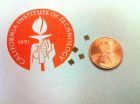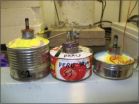(Press-News.org) PASADENA, Calif.—A secret agent is racing against time. He knows a bomb is nearby. He rounds a corner, spots a pile of suspicious boxes in the alleyway, and pulls out his cell phone. As he scans it over the packages, their contents appear onscreen. In the nick of time, his handy smartphone application reveals an explosive device, and the agent saves the day.
Sound far-fetched? In fact it is a real possibility, thanks to tiny inexpensive silicon microchips developed by a pair of electrical engineers at the California Institute of Technology (Caltech). The chips generate and radiate high-frequency electromagnetic waves, called terahertz (THz) waves, that fall into a largely untapped region of the electromagnetic spectrum—between microwaves and far-infrared radiation—and that can penetrate a host of materials without the ionizing damage of X-rays.
When incorporated into handheld devices, the new microchips could enable a broad range of applications in fields ranging from homeland security to wireless communications to health care, and even touchless gaming. In the future, the technology may lead to noninvasive cancer diagnosis, among other applications.
"Using the same low-cost, integrated-circuit technology that's used to make the microchips found in our cell phones and notepads today, we have made a silicon chip that can operate at nearly 300 times their speed," says Ali Hajimiri, the Thomas G. Myers Professor of Electrical Engineering at Caltech. "These chips will enable a new generation of extremely versatile sensors."
Hajimiri and postdoctoral scholar Kaushik Sengupta describe the work in the December issue of IEEE Journal of Solid-State Circuits.
Researchers have long touted the potential of the terahertz frequency range, from 0.3 to 3 THz, for scanning and imaging. Such electromagnetic waves can easily penetrate packaging materials and render image details in high resolution, and can also detect the chemical fingerprints of pharmaceutical drugs, biological weapons, or illegal drugs or explosives. However, most existing terahertz systems involve bulky and expensive laser setups that sometimes require exceptionally low temperatures. The potential of terahertz imaging and scanning has gone untapped because of the lack of compact, low-cost technology that can operate in the frequency range.
To finally realize the promise of terahertz waves, Hajimiri and Sengupta used complementary metal-oxide semiconductor, or CMOS, technology, which is commonly used to make the microchips in everyday electronic devices, to design silicon chips with fully integrated functionalities and that operate at terahertz frequencies—but fit on a fingertip.
"This extraordinary level of creativity, which has enabled imaging in the terahertz frequency range, is very much in line with Caltech's long tradition of innovation in the area of CMOS technology," says Ares Rosakis, chair of Caltech's Division of Engineering and Applied Science. "Caltech engineers, like Ali Hajimiri, truly work in an interdisciplinary way to push the boundaries of what is possible."
The new chips boast signals more than a thousand times stronger than existing approaches, and emanate terahertz signals that can be dynamically programmed to point in a specified direction, making them the world's first integrated terahertz scanning arrays.
Using the scanner, the researchers can reveal a razor blade hidden within a piece of plastic, for example, or determine the fat content of chicken tissue. "We are not just talking about a potential. We have actually demonstrated that this works," says Hajimiri. "The first time we saw the actual images, it took our breath away."
Hajimiri and Sengupta had to overcome multiple hurdles to translate CMOS technology into workable terahertz chips—including the fact that silicon chips are simply not designed to operate at terahertz frequencies. In fact, every transistor has a frequency, known as the cut-off frequency, above which it fails to amplify a signal—and no standard transistors can amplify signals in the terahertz range.
To work around the cut-off-frequency problem, the researchers harnessed the collective strength of many transistors operating in unison. If multiple elements are operated at the right times at the right frequencies, their power can be combined, boosting the strength of the collective signal.
"We came up with a way of operating transistors above their cut-off frequencies," explains Sengupta. "We are about 40 or 50 percent above the cut-off frequencies, and yet we are able to generate a lot of power and detect it because of our novel methodologies."
"Traditionally, people have tried to make these technologies work at very high frequencies, with large elements producing the power. Think of these as elephants," says Hajimiri. "Nowadays we can make a very large number of transistors that individually are not very powerful, but when combined and working in unison, can do a lot more. If these elements are synchronized—like an army of ants—they can do everything that the elephant does and then some."
The researchers also figured out how to radiate, or transmit, the terahertz signal once it has been produced. At such high frequencies, a wire cannot be used, and traditional antennas at the microchip scale are inefficient. What they came up with instead was a way to turn the whole silicon chip into an antenna. Again, they went with a distributed approach, incorporating many small metal segments onto the chip that can all be operated at a certain time and strength to radiate the signal en masse.
"We had to take a step back and ask, 'Can we do this in a different way?'" says Sengupta. "Our chips are an example of the kind of innovations that can be unearthed if we blur the partitions between traditional ways of thinking about integrated circuits, electromagnetics, antennae, and the applied sciences. It is a holistic solution."
INFORMATION:
The paper is titled "A 0.28 THz Power-Generation and Beam-Steering Array in CMOS Based on Distributed Active Radiators." IBM helped with chip fabrication for this work.
A new tool for secret agents -- and the rest of us
Caltech engineers make tiny, low-cost, terahertz imager chip
2012-12-11
ELSE PRESS RELEASES FROM THIS DATE:
Researcher finds gender differences in seasonal auditory changes
2012-12-11
ATLANTA – Auditory systems differ between sexes in sparrows depending on the season, a Georgia State University neuroscientist has found. The work adds to our knowledge of how the parts of the nervous system, including that of humans, are able to change.
Megan Gall, a post-doctoral researcher with Georgia State's Neuroscience Institute, tested the peripheral auditory systems of male and female house sparrows, comparing the hearing of each gender during non-breeding seasons and breeding seasons.
Gall measured frequency selectivity – the ability to tell sounds that are ...
Pharmacy researcher finds most popular weight-loss drug strongly alters other drug therapies
2012-12-11
KINGSTON, R.I.— December 10, 2012 – A University of Rhode Island researcher has discovered that the weight-loss drug orlistat, known by the brand names Xenical and Alli, inhibits a key enzyme that may lead to "severe toxicity of internal organs such as the liver and kidney." The inhibition is irreversible and can be caused by a low level of the drug.
Professor Bingfang Yan's study funded by the National Institutes of Health, also found that the drug alters efficacy of medicines, and particularly limits the effectiveness of some anti-cancer drugs.
Part of the research ...
Novel drug therapy targets aggressive form of non-Hodgkin's lymphoma
2012-12-11
NEW YORK (Dec. 10, 2012) -- Diffuse large B-cell lymphoma (DLBCL) is the most common subtype of non-Hodgkin's lymphoma and the seventh most frequently diagnosed cancer. The most chemotherapy resistant form of DLBCL, called activated B-cell – DLBCL (ABC-DLBCL), remains a major therapeutic challenge. An international research team, led by two laboratories from Weill Cornell Medical College, has developed a new experimental drug therapy to target this aggressive form of lymphoma.
In the journal Cancer Cell, researchers report the discovery of an experimental small molecule ...
Quantifying corn rootworm damage
2012-12-11
URBANA – Every year farmers spend a lot of money trying to control corn rootworm larvae, which are a significant threat to maize production in the United States and, more recently, in Europe. University of Illinois researchers have been working on validating a model for estimating damage functions.
Nicholas Tinsley, a doctoral candidate in crop sciences, has refined a model developed in 2009 by researchers at the University of Wisconsin and in Brescia, Italy, to describe the relationship between root injury caused by these pests and yield loss. He used the equivalent ...
Wayne State researcher finds possible clue to children's early antisocial behavior
2012-12-11
DETROIT - Both nature and nurture appear to be significant factors in early antisocial behaviors of adopted children, a Wayne State University researcher believes.
Christopher Trentacosta, Ph.D., assistant professor of psychology in the College of Liberal Arts and Sciences, recently examined data from 361 linked triads (birth mother, adoptive parents, adopted child) in order to assess externalizing behavioral problems such as aggression and defiance when children were 18, 27 and 54 months of age.
The triads were part of the Early Growth and Development Study (EGDS), ...
The dark side of kerosene lamps: High black-carbon emissions
2012-12-11
CHAMPAIGN, Ill. — The small kerosene lamps that light millions of homes in developing countries have a dark side: black carbon – fine particles of soot released into the atmosphere.
New measurements show that kerosene wick lamps release 20 times more black carbon than previously thought, say researchers at the University of Illinois and the University of California, Berkeley. The group published its findings in the journal Environmental Science and Technology.
Black carbon is a hazard for human health and the environment, affecting air quality both indoors and out. ...
Intensified chemotherapy shows promise for children with very high risk form of leukemia
2012-12-11
Young patients with an aggressive form of leukemia who are likely to relapse after chemotherapy treatment can significantly reduce those odds by receiving additional courses of chemotherapy, suggest the findings of a clinical trial led by investigators at Dana-Farber/Children's Hospital Cancer Center in Boston.
The trial leaders will present the results of the Dana-Farber Cancer Institute ALL Consortium study, which involved nearly 500 patients under age 18 with B-precursor acute lymphoblastic leukemia (B-ALL), at the annual meeting of the American Society of Hematology ...
As Amazon urbanizes, rural fires burn unchecked
2012-12-11
Over past decades, many areas of the forested Amazon basin have become a patchwork of farms, pastures and second-growth forest as people have moved in and cleared land--but now many are moving out, in search of economic opportunities in newly booming Amazonian cities. The resulting depopulation of rural areas, along with spreading road networks and increased drought are causing more and bigger fires to ravage vast stretches, say researchers in a new study. The study, focusing on the Peruvian Amazon, is the latest to suggest that land-use changes and other factors, including ...
Blood levels of immune protein predict risk in Hodgkin disease
2012-12-11
Blood levels of an immunity-related protein, galectin-1, in patients with newly diagnosed Hodgkin lymphoma reflected the extent of their cancer and correlated with other predictors of outcome, scientists reported at the American Society of Hematology annual meeting.
In a study of 315 patients from a German database, researchers from Dana-Farber Cancer Institute found that serum galectin-1 levels "are significantly associated with tumor burden and additional adverse clinical characteristics in newly diagnosed Hodgkin lymphoma (HL) patients."
The measurements were made ...
Conservatives can be persuaded to care more about the environment
2012-12-11
When it comes to climate change, deforestation and toxic waste, the assumption has been that conservative views on these topics are intractable. But new research from the University of California, Berkeley, suggests that such viewpoints can be changed after all, when the messages about the need to be better stewards of the land are couched in terms of fending off threats to the "purity" and "sanctity" of Earth and our bodies.
A UC Berkeley study has found that while people who identified themselves as conservatives tend to be less concerned about the environment than ...
LAST 30 PRESS RELEASES:
Duke and Duke-NUS’ joint cross-population research to uncover "East-West" differences in disease and care
Scientists to ‘spy’ on cancer- immune cell interactions using quantum technology breakthrough
Tech savvy users have most digital concerns
Making lighter work of calculating fluid and heat flow
Normalizing blood sugar can halve heart attack risk
Lowering blood sugar cuts heart attack risk in people with prediabetes
Study links genetic variants to risk of blinding eye disease in premature infants
Non-opioid ‘pain sponge’ therapy halts cartilage degeneration and relieves chronic pain
AI can pick up cultural values by mimicking how kids learn
China’s ecological redlines offer fast track to 30 x 30 global conservation goal
Invisible indoor threats: emerging household contaminants and their growing risks to human health
Adding antibody treatment to chemo boosts outcomes for children with rare cancer
Germline pathogenic variants among women without a history of breast cancer
Tanning beds triple melanoma risk, potentially causing broad DNA damage
Unique bond identified as key to viral infection speed
Indoor tanning makes youthful skin much older on a genetic level
Mouse model sheds new light on the causes and potential solutions to human GI problems linked to muscular dystrophy
The Journal of Nuclear Medicine ahead-of-print tip sheet: December 12, 2025
Smarter tools for peering into the microscopic world
Applications open for funding to conduct research in the Kinsey Institute archives
Global measure underestimates the severity of food insecurity
Child survivors of critical illness are missing out on timely follow up care
Risk-based vs annual breast cancer screening / the WISDOM randomized clinical trial
University of Toronto launches Electric Vehicle Innovation Ontario to accelerate advanced EV technologies and build Canada’s innovation advantage
Early relapse predicts poor outcomes in aggressive blood cancer
American College of Lifestyle Medicine applauds two CMS models aligned with lifestyle medicine practice and reimbursement
Clinical trial finds cannabis use not a barrier to quitting nicotine vaping
Supplemental nutrition assistance program policies and food insecurity
Switching immune cells to “night mode” could limit damage after a heart attack, study suggests
URI-based Global RIghts Project report spotlights continued troubling trends in worldwide inhumane treatment
[Press-News.org] A new tool for secret agents -- and the rest of usCaltech engineers make tiny, low-cost, terahertz imager chip


